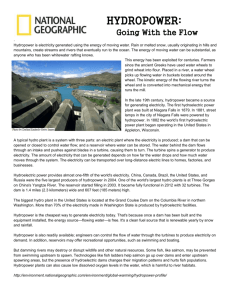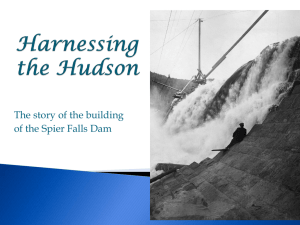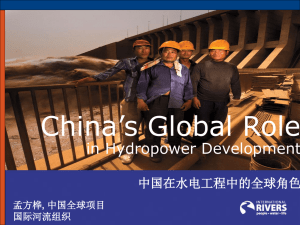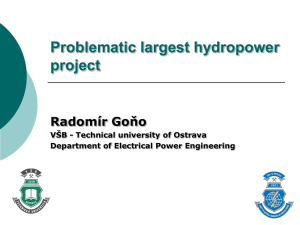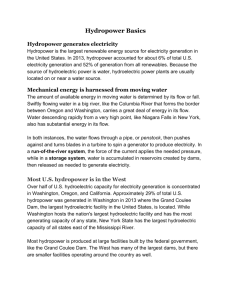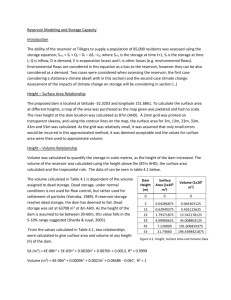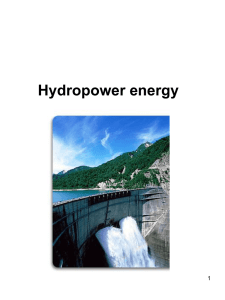Hydro Power - Chapman Historical Museum
advertisement
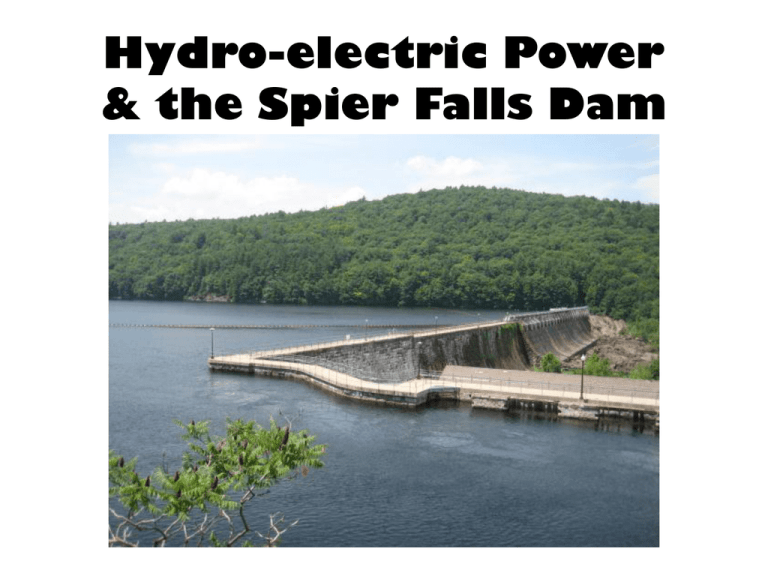
Hydro-electric Power & the Spier Falls Dam For centuries, humans have used falling water to provide power for grain and saw mills, as well as other activities. The 1st use of moving water to produce electricity was a waterwheel on the Fox River in Wisconsin in 1882, two years after Thomas Edison created the incandescent light bulb. As more and more motors and lighting devices were developed that used electricity, people adapted waterwheels and steam engines to produce electricity for local street lamps, storefronts and home lighting. As demand increased, the problem was the direct current used at that time could not transmit electricity over any great distance. When Westinghouse demonstrated alternating current at the 1893 Chicago Exposition a new era of hydropower began. Hydro electric power plants use water to create electricity - water is “borrowed” and “returned” after energy is derived from it. Plants like the Spier Falls Dam use dams to create large reservoirs of water that can be used on demand to create electricity. The water travels through underground gates called the “intake” into large pipes called “penstocks.” Water pressure builds up as the water travels through the penstock which leads to turbines that have been built deep inside the dam. As the water flows past the turbine, the blades begin to turn; this also turns magnets inside the generator which is attached to the turbine. The generator is where the electricity is produced. The large magnets inside the generator rotate past a copper coil, moving electrons around and creating alternating current (AC). U.S. Army Corps of Engineers The AC flows into a transformer that makes it a higher-voltage current (which costs less and travels more efficiently). Finally, the electric current travels out of the hydropower plant through power lines. Switch house and pole lines in Saratoga (from The Story of a Great Enterprise, 1903) Once the water has made its way through the hydroelectric plant, it is taken through pipelines called “tailraces” and returned to the river downstream. The photo above is the Spier Falls dam when the tailraces were stopped during construction; the photo at left shows the water flowing back to the river from the tailraces. The amount of electricity which can be generated at a hydroelectric plant is dependent upon two factors: the vertical distance the water flows (the “head”) and the rate of flow through the system. To estimate the amount of electricity that can be generated: POWER (kw) = 5.9 x FLOW x HEAD. (Flow measured in cubic meters per second and Head measured in meters). When the Spier Falls hydroelectric Dam was completed in 1903 it was - the 4th largest dam in the world - the largest built by private enterprise - the largest in the world used to generate electric power. The top three dams in the world at the time were in: - Aswan, Egypt on the River Nile spanning 1.25 miles for the purpose of irrigation - City of New York, 2180 feet in length for purpose of enlarging the Croton Reservoir - Clinton, Massachusetts, 850 feet long for purpose of creating a reservoir to supply water to Boston The Spier Falls Dam is 1,570 feet long, 157 feet high and 115 feet broad at its base, excavated to 64 feet below the riverbed and anchored to bedrock in an 8-foot trench carved in the rock. This means the dam is more than 4 football fields long… And as tall as a 15 story building! As many as 1700 people, many of them Italian immigrants, worked on the project. Power from 10 General Electric generators was sent via transformers to transmission lines. The generators produced 40-cycle alternating current, rather than the 60-cycle which is now standard. The transmission lines took electric power to customers downstream in the Hudson Valley, lighting homes and businesses from Glens Falls to Albany. While Spier Falls and a series of dams that followed it certainly put the power of the Hudson to good use, the river was far from tamed. Each year saw a cycle of spring floods followed by low water in dry seasons. The proposed solution was to build a dam on the Sacandaga River near the town of Conklingville. After 30 years of discussion, the Hudson River Regulating District hired an engineer to begin working on plans for the Reservoir in 1924. They had to buy up land, remove bridges, and relocate entire villages that would be submerged under the waters of the reservoir. The blue outline indicates the proposed boundary of the reservoir; trace the course of the Sacandaga River to get a sense of the amount of land that was submerged. Construction was completed in 1930. It produces electricity for 450,000 homes, and regulates waterflow from the reservoir to minimize area flooding during periods of high water, as well as increasing waterflow during dry periods. The reservoir that was created stretches 29 miles and covers 42.3 square miles. This body of water is called the Great Sacandaga Lake and has become a destination point for many boaters, fishermen and campers. Communities use the reservoirs at Conklingville and Spier Falls for boating and other water activities; it is important that everyone follow the posted safety regulations. Advantages to hydroelectric power: Fuel is not burned so there is minimal pollution Water to run the power plant is provided free by nature Hydropower plays a major role in reducing greenhouse gas emissions Relatively low operations and maintenance costs The technology is reliable and proven over time It's renewable - rainfall renews the water in the reservoir, so the fuel is almost always there Data from the U.S. Geological Survey: www.ga.water.usgs.gov Disadvantages to hydroelectric power: High investment costs Hydrology dependent (precipitation) In some cases, inundation of land and wildlife habitat In some cases, loss or modification of fish habitat Fish entrainment or passage restriction In some cases, changes in reservoir and stream water quality In some cases, displacement of local populations The hydropower plant at Conklingville is now run by Erie Boulevard Hydropower, L.P. and the Spier Falls Dam is owned by Brookfield Renewable Energy Partners, L.P. Over the years, technological advances have made it necessary to modify the dams and power plants. Also, today’s hydroelectric power companies have environmental management systems in place to lower the environmental impact of their operations.

